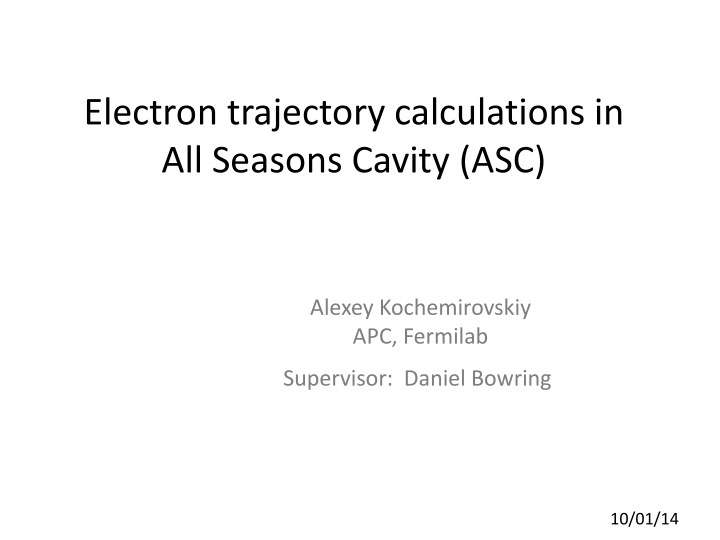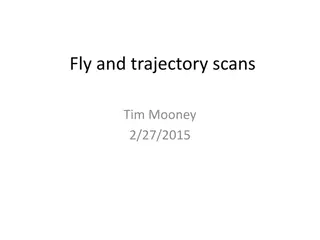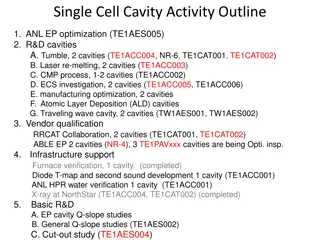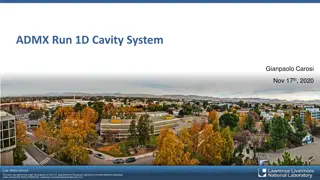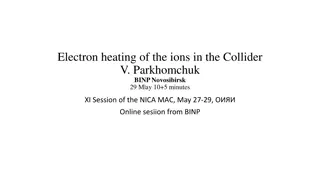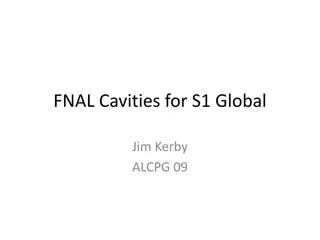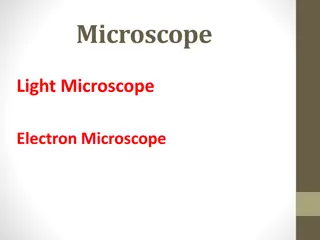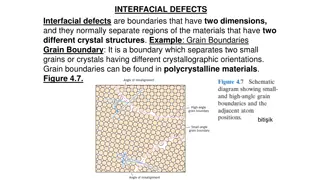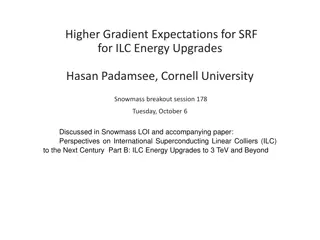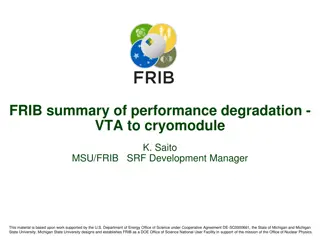Electron Trajectory Calculations in All Seasons Cavity Analysis
This analysis delves into electron trajectory calculations within the All Seasons Cavity (ASC), examining geometry, simulation models, misalignment effects, and the resulting angle distributions. Key findings include the impact of cavity misalignment on angle distributions and the need for further physical model development. Simulations, discussions, and pen-and-paper calculations complement the study to enhance simulation efforts.
Download Presentation

Please find below an Image/Link to download the presentation.
The content on the website is provided AS IS for your information and personal use only. It may not be sold, licensed, or shared on other websites without obtaining consent from the author.If you encounter any issues during the download, it is possible that the publisher has removed the file from their server.
You are allowed to download the files provided on this website for personal or commercial use, subject to the condition that they are used lawfully. All files are the property of their respective owners.
The content on the website is provided AS IS for your information and personal use only. It may not be sold, licensed, or shared on other websites without obtaining consent from the author.
E N D
Presentation Transcript
Electron trajectory calculations in All Seasons Cavity (ASC) Alexey Kochemirovskiy APC, Fermilab Supervisor: Daniel Bowring 10/01/14
Structure of the talk Previously on ASC Geometry, pit images, angle distribution ACE3P simulation model Simulation results, discussion Pen and paper calculations Model assumptions and parameters Some results Discussion
Geometry of ASC Cross-sectional plane of ASC f = 810MHz, Rc = 14.5cm
After December runs Pits are distributed uniformly on RF gap and Iris gap Pits are larger in size on Iris
Note: displacement is slightly increasing with radius Katsuya s slide
Simulations - model parameters Bz = 3T : [140, 200] Constant 20MV/m integrated field gradient One emitting surface - upstream endplate , one absorber - downstream endplate Introducing cavity misalignment |Bx|, |By| > 0 Checking both tilted and not-tilted scenarios
Simulations - angle distributions Different misalignment configurations give different angle distributions Bx = 0.02T By = -0.02T Bx = 0.02T By = 0.04T Bz = 3T Sometimes 2 visible peaks, sometimes just 1
Simulations : conclusions Cavity misalignment in magnetic field causes unsymmetrical angle distribution No visible difference between tilted and not-tilted case A lot of questions to the code developers to continue likely to be resolved after ACE3p workshop Biggest concern don t know the physical model of emission Discussion resulted in request for pen and paper calculations to complement simulation effort
Calculation model System of differential equations for electron motion inside the cavity. Code implemented in Mathematica RF fields are approximated by pillbox field solutions: E(r) pillbox-like dependence added RF B-field is pillbox-like E(z) dependence is taken into account -> fit External magnetic fields: Bz = 3T, Bx, By misaligment Fieldmap from MTA magnet is used for iris gap Eo = 20MV/m integrated field strength on axis What is not included: This is a singleelectron trajectory calculations Emission model ( although some estimates taken) Asymmetric geometrical features ( field enhancement near the coupler etc.)
System of equations Newton s second law Longitudinal motion Bx, By consist of: Relativistic correction Misalignment in external B field B RF component Br component for MTA magnet
Pillbox-like RF Magnetic field Is the scale of ?? ?~ 0.1 T need to take into account Indeed, pillbox-like!
Non-uniform external magnetic field Only forIRISGap R = 8cm (IRIS Gap) Data is taken from the MTA website for B=5T and linearly scaled to 3T
E(z) for Iris and RF gap (Katsuya s graph) Integrated field is higher for RF gap Surface field is stronger at IRIS
Impact energy versus initial phase Remember - time-dependent component is Eo sin ( 2 f t + ) But we re more interested in the energy of dark current
Fowler-Nordheim : determining initial phase Initial phase is a free parameter [0, 90o]. Which one to use? Work function where [ Norem et al, Dark current, breakdown, and magnetic field effects in a multicell, 805 MHz cavity ] Introducing the quantity, will call it current energy or deposited energy : The Impact energy of 1 electron Current density
Picking initial phase = 150 Deposited energy is of the same order of magnitude for = 500 Phi = 70o in further calculations
Initial energy, transverse momentum [ K. Jensen et al. Electron emission from a single spindt-type field emitter: Comparison of theory with experiment] 20o Knowing the range of initial kinetic energy, we can estimate the range of transverse momenta. Initial kinetic energy and transverse momentum terms I will use later are values electron has after leaving asperity region
EE Field Enhancement around Asperity 0 E E : Enhanced field from asperity : Local field (no asperity) 0 R ( m) The initial electron energy can be estimated to be in the ballpark of 10-100 keV Slide by Diktys Stratakis z ( m)
Pit orientation for different misalignments Ang_IRIS, o Ang_RF, o Bx, T By, T 0.02 -0.02 -8 3 -44 8 0.02 0.04 54 5 62 2 0.01 -0.03 -5 10 -68 2 0.03 0.01 32 7 20 5 Ranges: Ko up to 100keV, pxy up to 100keV/c
Pit offset for different Bz Misalignment is fixed 10 Ang_IRIS, o Ang_RF, o Bz, T Bx, T By, T 0 0 0 -52 -60 0.5 0.005 -0.005 28 -26 1 0.01 -0.01 16 -35 3 4 5 0.03 0.04 0.05 -0.03 -0.04 -0.05 -3 -6 -9 -42 -43 -43 = 70, px= py =0, Ko = 0
Displacement . Bessel like behavior Rc = 0.145m
Conclusion Model calculating trajectory of a single electron is implemented Results confirm the hypothesis that cavity misalignment in external magnetic field causes certain pit orientation RF Gap and IRIS Gap have different pit orientation Displacement is increasing with radius (needs analysis) What s next? Displacement analysis Calculations for pit sizes More precise emission model for better estimation of pit orientation ASC data search for interesting stuff Superfish simulations
Demotivation There are some open questions to ACE3P developers, that hinders further simulation effort. Some questions address physical model Example: There is no information regarding initial kinetic energy or transverse momenta of the electrons some are about technical details Example: ParticleType parameter has several possible values (2,3,5) in the output. The answeres are likely to be found during ACE3P workshop Oct 20 - 22 Discussion
Bx=By=0.03 Vxyzo =0 ; Rf Gap; Eo = 20MV/m; Initial Phase = 20 degrees
Bx=0.02T By=-0.02T Bx = 0.02T By = -0.02T
Displacement dependence of initial radius of emission Good agreement with Bessel function Do we see this? Model check
We can deduct the spread in Po from here Strong desire to interpret this graph in convenient way
Pit size Most confusing graph in my life
